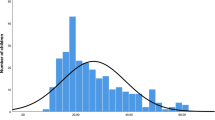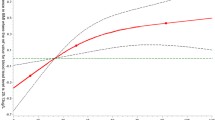Abstract
The purpose of this study was to investigate environmental lead exposure in the general Taiwanese population. A total of 8828 Taiwanese adults selected by a multistage sampling method were investigated. Characteristics of the participants were ascertained by questionnaire and 10 ml venous blood was drawn by public health nurses. The blood specimens were distributed to six laboratories for blood lead level (BLL) measurement. A quality control program was applied during the analysis of the BLLs in order to improve precision and accuracy. The arithmetic mean BLL of the 8828 Taiwanese adults was 7.70 ± 5.23 μg/dl, with a maximal level of 69.1 μ/dl. The median was 6.5 μ/dl and the 90th percentile was 14.0 μg/dl. After logarithmic transformation, the geometric mean was 1.84 ± 0.67 μg/dl. This study also found that elevated BLLs were associated with certain personal characteristics, i.e., gender, ethnic group, and education level; life-style factors, such as smoking, alcohol consumption, Chinese herbal drug consumption, milk consumption, and sources of drinking water; residential location, i.e., level of urbanization; and occupational history of lead exposure. However, age, floor level of residence, distance from house to road, and betel nut consumption were not associated with elevated BLLs. These results showed that BLLs in the Taiwanese population were not higher than those in developed and developing countries. Most of the influencing factors were also found in other studies; however, local factors such as ethnic group, Chinese herbal drug consumption, and sources of drinking water are important considerations in Taiwan when examining ways to prevent overexposure to lead in the general population.
Similar content being viewed by others
References
Agency for Toxic Substances and Disease Registry (1988) The nature and extent of lead poisoning in children in the United States: a report to Congress. US Department of Health and Human Services, Public Health Services, Atlanta, Ga.
Antonini G, Fericuti S, Pennisi E, Monarca B (1989) Wine poisoning as a source of lead intoxication. Am J Med 87:238–239
Berode M, Wietlisbach V, Rickenbach M, Guillemin MP (1991) Lifestyle and environmental factors as determinants of blood lead levels in a Swiss population. Environ Res 55:1–17
Bortoli A, Fazzin G, Marin V, Trabuio G, Zotti S (1986) Relationships between blood lead concentration and aminolevulinic acid dehydratase in alcoholics and workers industrially exposed to lead. Arch Environ Health 41:251–260
Brockhaus A, Freier L, Ewers U, Jermann E, Dolgner R (1983) Levels of cadmium and lead in blood in relation to smoking, sex, occupation, and other factors in an adult population on the FRG. Int Arch Occup Environ Health 52:167–175
Brody DJ, Pirkle JL, Kramer RA, Flegal KM, Matte TD, Gunter EW, Paschal DC (1994) Blood lead levels in the US population. Phase 1 of the Third National Health and Nutrition Examination Survey (NHANES III, 1988 to 1991). JAMA 272:277–283
Ducoffre G, Claeys F, Bruaux P (1990) Lowering time trend of blood lead levels in Belgium since 1978. Environ Res 51:25–34
Grandjean P, Olsen NB, Hollnagel H (1981) Influence of smoking and alcohol consumption on blood lead levels. Int Arch Occup Environ Health 48:391–397
Hung IJ (1980) Lead poisoning in two families. J Formos Med Assoc 79:740–748
Hwang YF, Strickland GT, Chang NK, Beckner WM (1976) Chronic industrial exposure to lead in 63 subjects I. Clinical and erythrokinetic findings. Southeast Asian J Trop Med Public Health 7:87–97
Hwang YH, Wang JD (1990) Temporal fluctuation of the lead level in the cord blood of neonates in Taipei. Arch Environ Health 45:42–45
Lin HT, Wong SS, Li GC (1992) The concentrations of heavy metals in corps of Taiwan and the daily intake of heavy metals by R.O.C. people. J Chin Agric Chem Soc 30:463–470
Liou SH, Gu TL, Hsu SW, Wu DM, Chen LM (1994) A review of occupational and environmental lead poisoning in Taiwan. J Occup Safety Health 1:12–26
Liou SH, Wu TN, Chiang HC, Yang GY, Wu YQ, Lai JS, Ho ST, Guo YL, Ko YC, Chang PY (1994) Blood lead levels in the general population of Taiwan, Republic of China. Int Arch Occup Environ Health 66:255–260
Mahaffey KR, Annest JL, Roberts J, Murphy RS (1982) National estimates of blood lead levels: United States, 1976–1980. N Engl J Med 307:573–579
Parsons PJ (1992) Monitoring human exposure to lead: an assessment of current laboratory performance for the determination of blood lead. Environ Res 57:149–162
Pirkle JL, Brody DJ, Gunter EW, Kramer RA, Paschal DC, Flegal KM, Matte TD (1994) The decline in blood lead levels in the United States. The National Health and Nutrition Examination Surveys (NHANES). JAMA 272:284–291
Qu JB, Jin C, Lui YT (1988) Blood lead levels of the general populations of three Chinese cities. Sci Total Environ 77:35–44
Quinn MJ, Delves HT (1988) UK blood lead monitoring program 1984–1987: results for 1985. Hum Toxicol 7:105–123
Shaper AG, Pocock SJ, Walker M, Wale CJ, Clayton B, Delves HT, Hinks L (1982) Effects of alcohol and smoking on blood lead in middle-aged British men. Br Med J 284:299–302
Wang JD, Jang CS, Hwang YH, Chen ZS (1992) Lead contamination around a kindergarten near a battery recycling plant. Bull Environ Contamin Toxicol 49:23–30
World Health Organization Regional Office for Europe (WHO) (1987) Air quality guidelines for Europe. Copenhagen, pp 242–261 (WHO Regional Publications, European Series, 23)
Yip PK, Chang YC, Wang JD, Tsai SY, Chen JS (1988) Small outbreak of lead neuropathy in a tile factory. J Formos Med Assoc 87:60–64
Zielhuis RL, Stuik EJ, Herber RFM, Salle JJA, Verberk MM, Posma FD, Jager JH (1977) Smoking habits and levels of lead and cadmium in blood in urban women. Int Arch Occup Environ Health 39:53–58
Author information
Authors and Affiliations
Rights and permissions
About this article
Cite this article
Liou, SH., Wu, TN., Chiang, HC. et al. Three-year survey of blood lead levels in 8828 Taiwanese adults. Int. Arch Occup Environ Heath 68, 80–87 (1996). https://doi.org/10.1007/BF00381239
Received:
Accepted:
Issue Date:
DOI: https://doi.org/10.1007/BF00381239




